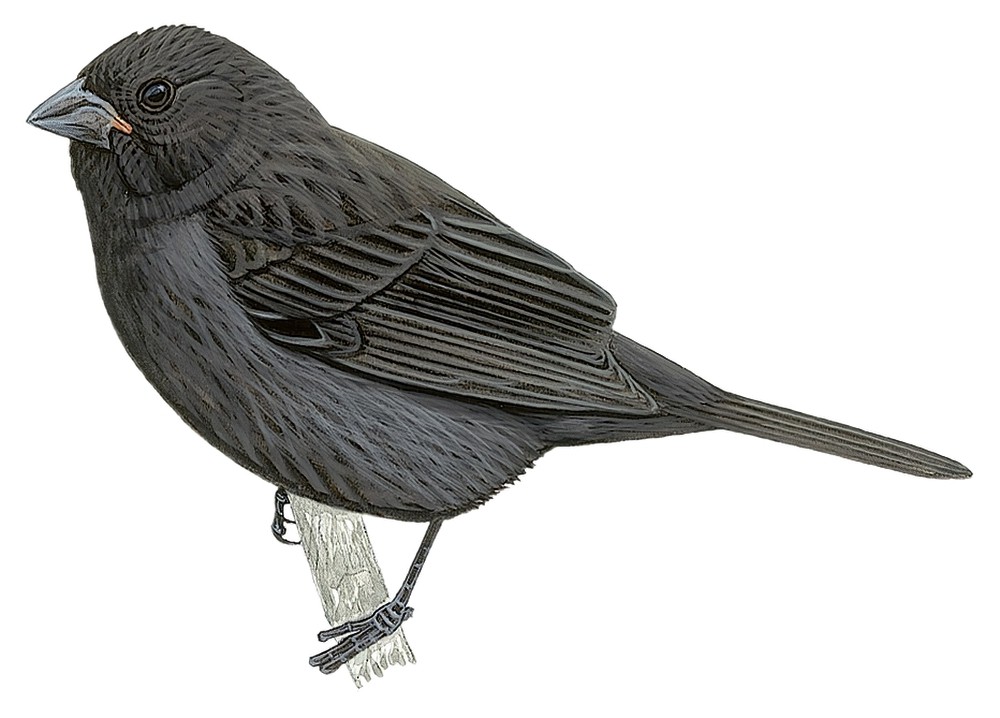Sooty Grassquit / Asemospiza fuliginosa

Sooty Grassquit
SCI Name:
Protonym: Fringilla fuliginosa Beitr.Naturgesch.Brasil. 3 p.628
Taxonomy: Passeriformes / Thraupidae / Asemospiza
Taxonomy Code: soogra2
Type Locality: Camamu, Bahia, Brazil.
Author: zu Wied
Publish Year: 1830
IUCN Status: Least Concern
DEFINITIONS
ASEMOSPIZA
(Thraupidae; † Sooty Grassquit A. fuliginosa) Gr. ασημος asēmos without distinguishing marks < negative prefix α- a- ; σημα sēma, σηματος sēmatos mark, sign; σπιζα spiza finch < σπιζω spizō to chirp; "7. Asemospiza, new genus (Fig. 2) Type species. Fringilla fuliginosa Wied, 1831, currently recognized as Tiaris fuliginosus. Included species. Asemospiza fuliginosa (Wied, 1831) and A. obscura (d'Orbigny & Lafresnaye, 1837), the latter currently recognized as T. obscurus. ... Etymology. Asemospiza is formed from the Greek ασημος, "unmarked," in reference to the unstreaked drab plumage of the two component species, and Greek σπιζα, the chaffinch Fringilla coelebs, commonly used in ornithology in the coining of names of finch-like birds. Its gender is feminine, in accord with Greek grammar." (Burns et al. 2016) (OD per Richard Klim); "Asemospiza Burns, Unitt and Mason, 2016, Zootaxa, 4088 (3), p. 334. Type by original designation, Fringilla fuliginosa zu Wied, 1830." (JAJ 2020).
fuliginosa / fuliginosum / fuliginosus
Late L. fuliginosus sooty, covered with soot < L. fuligo, fuliginis soot.
● ex “Soui-manga carmelite” of Audebert & Vieillot 1802 (Chalcomitra).
● ex “Grimpar Enfumé” of Levaillant 1807, pl. 28 (Dendrocincla).
● ex “Sooty Petrel” of Latham 1785 (Nesofregetta).
● ex “Sooty or Brown Albatros” of Latham 1785 (syn. Phoebetria palpebrata).
● ex “Hirondelle de Mer à grande envergure” of de Buffon 1770-1783, and “Sooty Tern”, “Simple Tern, var. A” and “Dusky Tern” of Latham 1785 (syn. Onychoprion fuscatus).
● ex “Gobe-mouche brun de Cayenne” of d’Aubenton 1765-1781, pl. 574, fig. 1, and “Brown Fly-catcher” of Latham 1783 (unident.; has been linked with Cnemotriccus fuscatus and with Contopus cinereus).
UPPERCASE: current genus
Uppercase first letter: generic synonym
● and ● See: generic homonyms
lowercase: species and subspecies
●: early names, variants, mispellings
‡: extinct
†: type species
Gr.: ancient Greek
L.: Latin
<: derived from
syn: synonym of
/: separates historical and modern geographic names
ex: based on
TL: type locality
OD: original diagnosis (genus) or original description (species)












